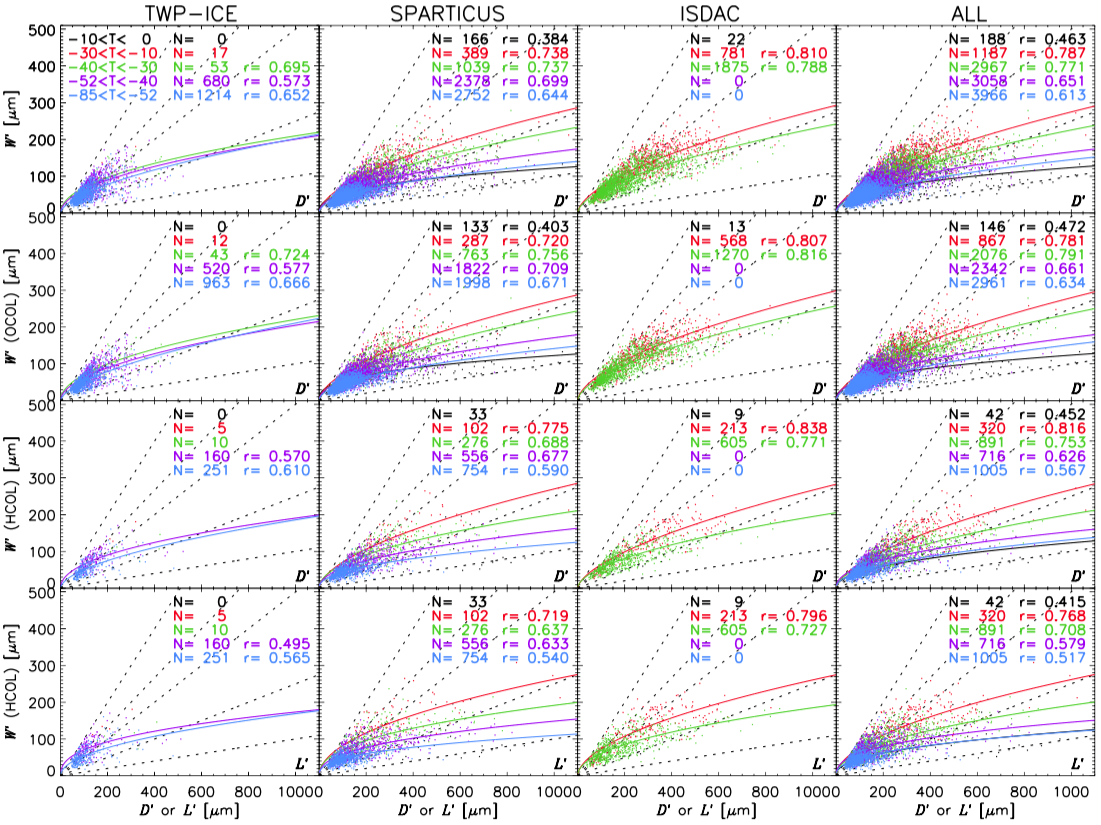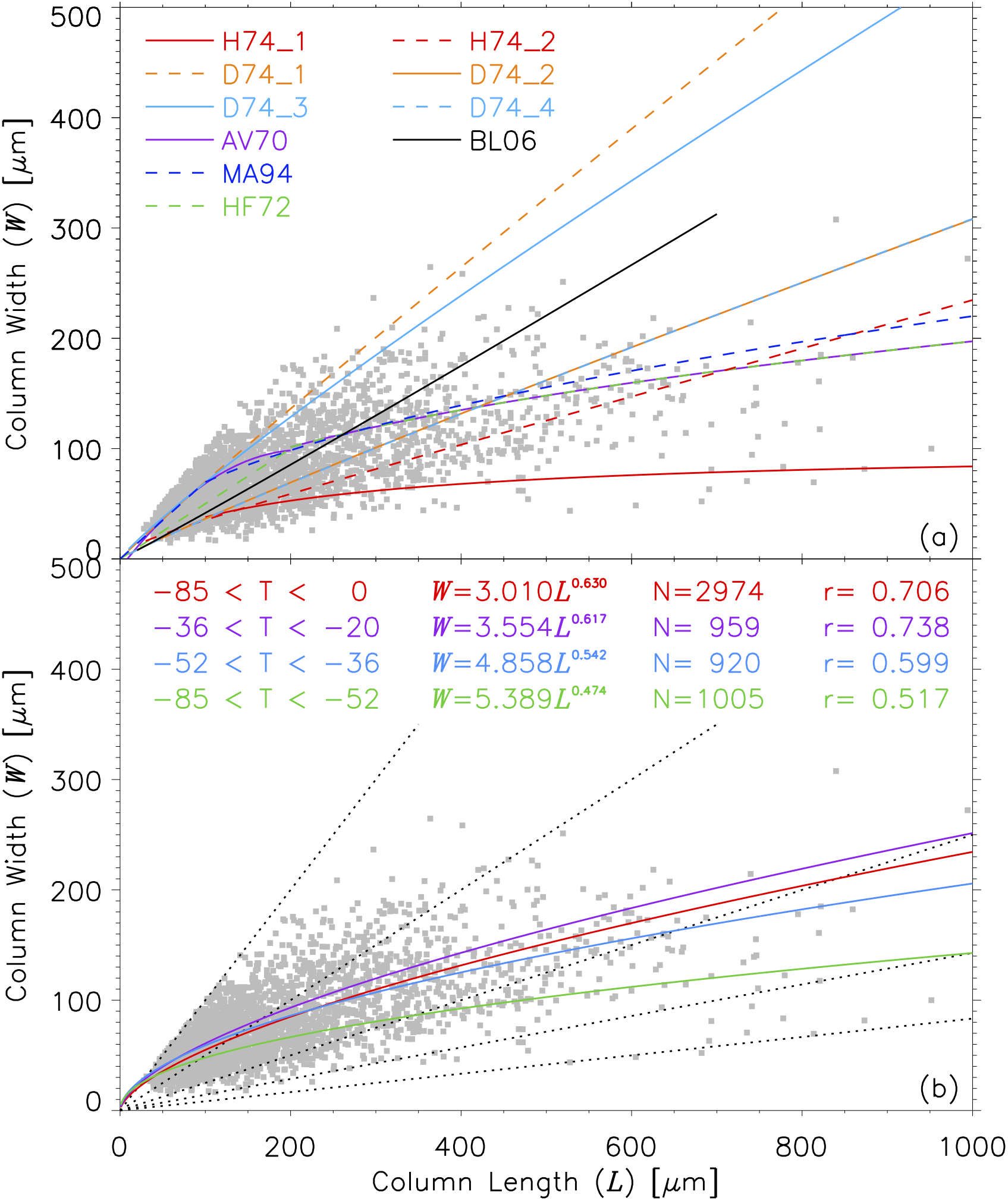Single Particle Database of Natural Ice Crystals: Dimensions and Aspect Ratios
Submitter:
Um, Junshik — Pusan National University
McFarquhar, Greg — University of Oklahoma
Area of research:
Cloud Distributions/Characterizations
Journal Reference:
Science
Accurate knowledge of dimensions and of length (L)–width (W) relationships for ice crystals is important because it is needed to construct shape models for calculating the single-scattering (e.g., scattering phase function and asymmetry parameter) and microphysical (e.g., area and fall velocity) properties of ice crystals. Prior studies have shown that the assumed L–W relationship impacts the results of satellite retrievals, and numerical simulations. Past studies have quantified the L–W relationship or aspect ratio (AR, dimension of major axis divided by dimension of minor axis) of natural ice crystals based on laboratory measurements and in situ data. However, most such work was based on a limited number of measured crystals observed within a limited temperature (T) range in a single geographic regime. This study considerably extends past efforts by using a much larger number of ice crystals imaged in a variety of conditions and locations to determine what controls L–W relationships and ARs of individual crystals. In particular, the dimensions of hexagonal prisms (i.e., columns and plates) and individual branches (i.e., bullets) of bullet rosettes were obtained from high-resolution ice crystal images recorded by a Cloud Particle Imager (CPI) during three previous ARM field campaigns.
Impact
During the 2006 Tropical Warm Pool International Cloud Experiment (TWP-ICE), the 2008 Indirect and Semi-Direct Aerosol Campaign (ISDAC) in the Arctic, and the 2010 Small PARTicles In CirrUS (SPARTICUS) campaign at mid-latitudes, 2.3 µm resolution images of ice crystals were recorded by a CPI at T between −87 and 0 °C. The projected maximum dimension (D’), length (L’), and width (W’) of pristine columns, plates, and component bullets of bullet rosettes were measured using newly developed software at the University of Illinois, the Ice Crystal Ruler. The number of bullets in each bullet rosette was also measured. Column crystals were further distinguished as either horizontally oriented columns or columns with other orientations to eliminate any orientation effect on the measured dimensions. Dimensions and ARs of crystals were determined as functions of T, geophysical location, and type of cirrus. Dimensions of crystals generally increased with T. Columns and bullets had larger dimensions (i.e., W’ ) of the minor axis (i.e., a axis) for a given dimension (i.e., D’ or L’) of the major axis (i.e., c axis), and thus smaller AR, as T increased (see Figure 1), whereas this trend did not occur for plate crystals. The average number of branches in bullet rosettes was 5.50±1.35 over all campaigns and 6.32±1.34 (5.46±1.34; 4.95±1.01) during TWP-ICE (SPARTICUS; ISDAC). The AR of bullets increased with the number of branches in bullet rosettes. Most dimensions of crystals and ARs of columnar crystals measured during SPARTICUS were larger than those measured during TWP-ICE and ISDAC at -67<T<-35°C and at -40<T<-15°C, respectively. The relative occurrence of varying pristine habits depended strongly on cirrus type (i.e., anvil or non-anvil clouds), with plates especially occurring more frequently in anvils. The L–W relationships of columns derived using current data exhibited a strong dependence on temperature; similar relationships determined in previous studies were within the range of the current data (see Figure 2).
Summary
In this study, a single particle database has been established and will be enlarged using in situ observations acquired under other meteorological conditions. The influence of particle orientations on the actual particle properties (e.g., dimensions and ARs) that is unavoidable in airborne optical array and imaging probes will be quantified in a subsequent study. Although the influence of humidity on the growth of ice crystals was not included because of the unavailability of good-quality humidity measurements, future studies should examine such effects with other data sets. These large databases are essential and important to represent the wide spread of microphysical and radiative properties of ice crystals for retrieval algorithms and numerical modeling studies.



